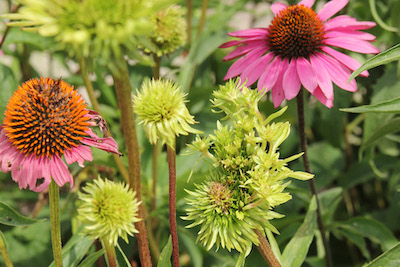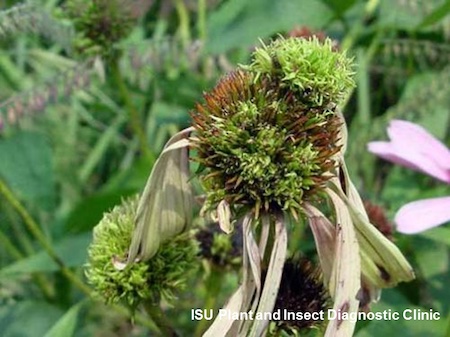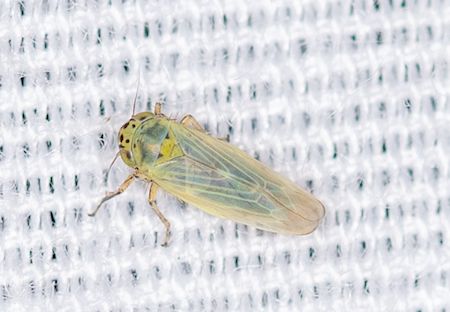Aster Yellows: A Deadly Garden Disease
by Mimi Dunham, Fairfax Master Gardener

Aster Yellows on Coneflowers
Aster yellows Is a plant disease that affects over 300 different plants, including ornamentals, vegetables and weeds. Aster yellows mainly infects plants in the aster family, Asteraceae.
The disease is transmitted by a bacterium called a phytoplasm. The aster leafhopper, Macrosteles quadrilineatus, a piercing sucking insect, feeds on the sap of an infected plant. The aster leafhopper then transfers the pathogen to every plant it feeds on. There are other leafhoppers, but this leafhopper is specific to the disease aster yellows.
The symptoms are unusual and varied depending on the infected plant.
This disease commonly is observed in purple coneflower plants (Echinacea purpurea). The disease will present in purple coneflowers as brush-like shoots from the center of the coneflower. This can look like an extra flower in the coneflower center. This abnormal growth often is called a witch’s broom.

Small deformed leaves replaced the Coneflower flowerhead
The symptoms often do not appear immediately when the aster leafhopper is observed, as the pathogen may take ten days to three weeks to develop. It takes three weeks for the pathogen to travel to the leaf hopper’s salivary glands. The first sign of infection can be the loss of green color in the plant’s leaves. Other symptoms include stunted or abnormal growth, wilt, dieback and different coloration (yellow, purple or red).
The bacterium carried by the aster leafhopper can infect all parts of the plant. However, the disease does not remain in the soil as the bacterium cannot survive outside the plant.
Some ornamentals affected by aster yellows are coneflower, daisy, marigold, zinnia, snapdragon and chrysanthemum. Some vegetables that may exhibit symptoms are tomato, carrot, lettuce and potato.

Aster Leafhopper
Ornamental plants and weeds can harbor the disease, but without showing any symptoms. Wild carrot, field daisy, dandelion, ragweed, marestail, pineapple weed, goldenrod and plantain are examples. Eliminating weeds in the garden and landscape will provide some control.
There are no chemical controls for the bacterium. Controlling the aster leafhopper in the home garden is not feasible or effective. Management of the disease consists of removing the entire plant, including the roots. Cutting off only the infected part of the plant is not enough to control the disease. Without removing the entire diseased plant, aster yellows will spread.
Aster yellows can be confused with herbicide damage. Damage of the eriophyid mite from the family Eriophyidae has damage that can mimic aster yellows. Herbicide and eriophyid mite damage, however, do not require plant removal.
Since there is no control except plant removal, it is important for the gardener to inspect plants regularly to prevent contamination. Infected perennials usually die in the first season.
The pathogen can occur in both cool and hot seasons. The aster leafhoppers come in on winds and the jet stream from southern states along the Gulf coast. The aster leafhoppers then spread north. The pathogen, phytoplasm, remains in the aster leafhopper for the duration of its life cycle.
-
References
- Aster Leafhopper, B. Lenzen and WD Hutchison, Dept. of Entomology, University of Minnesota
- Aster Yellows Disease on Flowers, David Clement and Karen Rane, University of Maryland Extension
- Aster Yellows, Missouri Botanical Garden